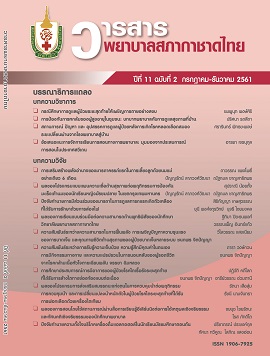กรณีศึกษาการดูแลผู้ป่วยระยะสุดท้ายให้เผชิญการตายอย่างสงบ
คำสำคัญ:
ผู้ป่วยระยะสุดท้าย, การตายอย่างสงบ, การดูแลแบบประคับประคองบทคัดย่อ
มนุษย์ทุกคนปรารถนาการตายอย่างสงบ แต่การตายอย่างสงบมิใช่จะเกิดได้ในทุกคน พยาบาลช่วยผู้ป่วยระยะสุดท้ายให้ตายอย่างสงบได้โดยให้การดูแลร่วมกับทีมสหสาขาวิชาชีพ ปัจจัยที่มีผลต่อการตายอย่างสงบได้แก่ ทัศนคติต่อความตาย ค่านิยมของสังคมต่อความตาย ความศรัทธายึดมั่นในศาสนา รวมทั้งความทุกข์ทรมานด้านร่างกาย จิตใจและจิตวิญญาณ จากประสบการณ์เป็นอาสาสมัครในบทบาทพยาบาลดูแลผู้ป่วยระยะสุดท้ายในโรงพยาบาล ได้นำการดูแลแบบประคับประคองมาใช้ โดยมีเทคนิคการสื่อสารเพื่อการรักษาเป็นเครื่องมือในการค้นหาปัญหา แนวคิด ความเชื่อของผู้ป่วย นอกจากนั้นนำการฝึกพิจารณามรณสติ รวมทั้งการภาวนาโพวาและทองเลนซึ่งเป็นการภาวนาแบบธิเบตมาเป็นวิถีสู่การตายดี และจากกรณีศึกษาผู้ป่วยระยะสุดท้าย 2 ราย พบว่าการตายอย่างสงบขึ้นอยู่กับองค์ประกอบหลายประการ ทั้งบุคลิกภาพและแนวคิดที่เป็นปัจจัยภายในของบุคคล ผู้ที่ยอมรับความจริงและไม่กลัวความตาย ย่อมพบกับความตายอย่างสงบและครอบครัวยอมรับการจากไปได้ แต่ในผู้ป่วยที่ไม่มีการเตรียมตัวเตรียมใจมาก่อน จะยิ่งทุกข์ทรมานทั้งร่างกายและจิตใจ อีกทั้งเป็นความเศร้าโศกเสียใจอย่างยิ่งของครอบครัว
เอกสารอ้างอิง
2. Granda-Cameron C, Houldin A. Concept analysis of good death in terminally ill patients. Am J Hosp Palliat Care 2012;29(8):632-9.
3. Rosser M, Walsh HC. Fundamentals of palliative care for student nurses. Oxford: John Wiley & Sons; 2014.
4. Cheng SY, Hu WY, Liu WJ, Yao CA, Chen CY, Chiu TY. Good death study of elderly patients with terminal cancer in Taiwan. Palliat Med 2008;22(5):626-32.
5. ธนัช กนกเทศ. สังคมวิทยาสาธารณสุข. พิษณุโลก: สำนักพิมพ์มหาวิทยาลัยนเรศวร; 2559.
6. วัลภา คุณทรงเกียรติ. การตายดีตามการรับรู้ของผู้ป่วยมะเร็ง. วารสารคณะพยาบาลศาสตร์ มหาวิทยาลัยบูรพา 2556;21(4):25-36.
7. รจนา ทองดำ, วราภรณ์ คงสุวรรณ, กิตติกร นิลมานัต. การตายอย่างสงบตามมุมมองของพยาบาลไทยมุสลิม. วารสารพยาบาลสงขลานครินทร์ 2558;35(2):21-34.
8. พระไพศาล วิสาโล. การช่วยเหลือผู้ป่วยระยะสุดท้ายด้วยวิธีแบบพุทธ. ใน: ไพศาล ลิ้มสถิตย์, อภิราชย์ ขันธเสน, บรรณาธิการ. ก่อนวันผลัดใบ: หนังสือแสดงเจตนาการจากไปในวาระสุดท้าย. พิมพ์ครั้งที่ 2. กรุงเทพฯ: เอมี่ เอนเตอร์ไพรส์; 2552. หน้า 30.
9. สุวรรณา อุชุคตานนท์. อยู่อย่างมีความหมายตายอย่างมีชีวิต. กรุงเทพฯ: 108 สุดยอดไอเดีย; 2548.
10. สุรินทร์ จิรนิรามัย. การดูแลด้านจิตใจและจิตวิญญาณในแนวทางพระพุทธศาสนา. ใน: บุษยามาส ชีวสกุลยง, อารีวรรณ สมหวังประเสริฐ, สุรินทร์ จิรนิรามัย, เบญจลักษณ์ มณีทอน, ธนินนิตย์ ลีรพันธ์, ชนัญญา มหาพรหม,และคนอื่นๆ. การดูแลผู้ป่วยแบบประคับประคอง Palliative care. เชียงใหม่: กลางเวียงการพิมพ์; 2556. หน้า 250.
11. Kinzbrunner BM, Policzer JS. End of life care: a practical guide. 2nd ed. New York: McGraw-Hill; 2011.
12. Souza JD, Pettier A. End of life nursing care: a guide for best practice. London: SAGE; 2013.
13. Emanuel EJ, Hauser J, Emanuel LL, Palliative and end-of-life care. In: Fauci AS, Braunwald E, Kasper DL, Hauser SL, Longo DL, Jameson JL, et al, editors. Harrison’ principles of internal medicine. 17th ed. New York: McGraw Hill; 2008. p. 66-80.
14. Taylor C, Littis C, Lynn P, LeMone P. Fundamentals of nursing: the art and science of person-center nursing care. 8th ed. Philadelphia: Lippincott; 2015.
15. Bruera E, Higginson I, Gunten CF, Morita T. Textbook of palliative medicine and supportive care. 2nd ed. New York: Taylor & Francis Group; 2015.
16. Timby BK. Fundamental nursing skills and concepts. 11th ed. Philadelphia: Wolters Kluwer; 2017.
17. มนธิดา แสงเรืองเอก, บำเพ็ญจิต แสงชาติ. ผลของการสร้างจินตภาพต่อความปวดและจำนวนครั้งของการได้รับยาแก้ปวดในผู้ป่วยมะเร็งปากมดลูกระยะลุกลาม.วารสารพยาบาลศาสตร์และสุขภาพ 2554;34(3):1-10.
18. Synder M, Lindquist R. Complementary and alternative therapies in nursing. 6th ed. New York: Springer; 2010.
19. พระไพศาล วิสาโล. มรณสติ. กรุงเทพฯ: ชมรมกัลยาณธรรม; 2552.
20. พระมหาสุพร รกฺขิตธมฺโม. ศึกษาวิเคราะห์การเผชิญความตายอย่างสงบตามหลักมรณสติในพระพุทธศาสนาเถรวาท [สารนิพนธ์ปริญญาพุทธศาสตรดุษฎีบัณฑิต สาขาวิชาพระพุทธศาสนา]. กรุงเทพฯ: มหาวิทยาลัยมหาจุฬาลงกรณราชวิทยาลัย; 2557.
21. พระไพศาล วิสาโล. ซีดีเสียงเครือข่ายพุทธิกา “โพวา ทองเลน ภาวนาเพื่อการเยียวยา” [อินเทอร์เน็ต]. [เข้าถึงเมื่อ 16 ต.ค. 2559]. เข้าถึงได้จาก: https:// https://www.youtube.com/watch?v= YfsDc8rIZ5M&index=1&list=RDYfsDc8rIZ5M
22. Rinpoche S. The Tibetan book of living and dying [Internet]. 2011 [cited 2017 Oct 16]. Available from: https://www.anamcarathai.com/2011/12/phowa-practice.html
23. รินโปเช, โซเกียล. ประตูสู่สภาวะใหม่ คำสอนธิเบตเพื่อเตรียมตัวตายและช่วยเหลือผู้ใกล้ตาย. พิมพ์ครั้งที่ 5. กรุงเทพฯ: มูลนิธิโกมลคีบทอง; 2554.
24. กฤษดาวรรณ เมธาวิกุล. ทงเลน: วิถีแห่งการละอัตตา. กรุงเทพฯ: มูลนิธิพันดารา; 2557.
25. กาญจนา จิตต์วัฒน. การบูรณาการการเตรียมตัวตายในพระพุทธศาสนาเถรวาทกับวัชรยาน [วิทยานิพนธ์ปริญญาพุทธศาสตรดุษฎีบัณฑิต สาขาวิชาพระพุทธศาสนา]. กรุงเทพฯ: มหาวิทยาลัยมหาจุฬาลงกรณราชวิทยาลัย; 2553.
ดาวน์โหลด
เผยแพร่แล้ว
ฉบับ
ประเภทบทความ
สัญญาอนุญาต
เนื้อหาบทความหรือข้อคิดเห็นต่างๆ ในวารสารพยาบาลสภากาชาดไทยนี้ เป็นความคิดเห็นของผู้เขียนบทความ ไม่ใช่ความเห็นของกองบรรณาธิการ หรือสถาบันการพยาบาลศรีสวรินทิรา สภากาชาดไทย






